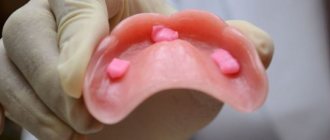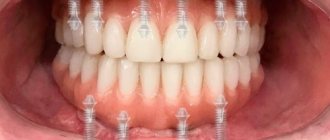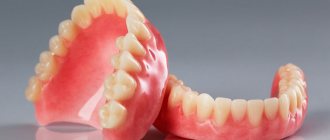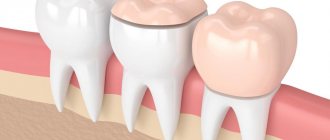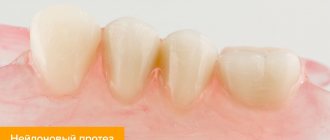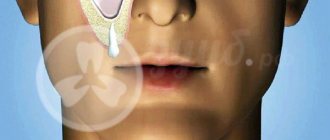Acrylic removable dentures
Acrylic dentures have been used in dentistry for a long time; they are light and unnoticeable, but at the same time bulky and rigid, which causes discomfort when using them.
The advantages of such prostheses are their weight and inconspicuousness to others. They are easy to repair or change the design if the gums shrink over time.
The disadvantage of acrylic dentures, in addition to some discomfort in use, is a rather long period of adaptation, during which there is salivation, problems with diction, a change in taste sensitivity, and sometimes allergies. It is not advisable to chew hard food, chewing gum, or sticky sweets with such dentures. A significant disadvantage of acrylic dentures is their base. Acrylic, reacting with saliva, releases toxic substances that can cause poor health.
The price of this type of prosthesis is affordable for almost everyone and is a good replacement for fixed prosthetics if it is impossible for some reason.
Nylon or silicone dentures
This type of prosthesis is similar to acrylic, but made from more modern and safe materials. Nylon is softer and more elastic, the prosthesis looks better than acrylic ones, but they are also fixed - not quite reliably. Due to the softness of the system, these dentures will not allow you to chew food well; in addition, they load the gums in this way, which over time leads to atrophy of the jaw bone tissue.
Nylon dentures have the following advantages: the absence of allergic reactions, due to the absence of pores in the material, they do not absorb moisture and odors, getting used to them is faster than acrylic ones, they do not rub the gums, are practically invisible to others and have antimicrobial properties.
The disadvantages include: uneven load distribution, short lifespan (3-4 years) and impossibility of repair, high price compared to acrylic ones. Another disadvantage is the problem of a massive base, which, covering the entire palate, causes problems with diction. The elasticity of the nylon prosthesis material is also its disadvantage. Due to the flexible base, the load during chewing is transferred only to the area where food is currently being chewed, this leads to accelerated atrophy of bone tissue.
What is an end defect?
Losing the attractiveness and integrity of a smile is a real disaster for most people. But, unfortunately, there are people for whom the loss of a tooth or even teeth is absolutely no reason to see a dentist. Especially when it comes to back molars.
Loss of the back teeth of the upper or lower jaw is called an end defect
– and this is truly one of the most important and complex problems in prosthetic dentistry. First of all, due to the enormous functional load that the posterior (chewing) teeth bear.
“Just think, my back teeth are falling out! You still can’t see them when you smile!”
Of course, this is a misconception. After all, the point is far from being about the beauty of a smile, but about a functional disorder of the dental system, which provokes many serious dental diseases. The absence of back teeth will sooner or later trigger a process of negative consequences in relation to both the central teeth and the smile line.
Fixed dentures on implants
Classic implantation. This method of restoring teeth in the absence of teeth makes it possible to reproduce functionally and aesthetically natural teeth as closely as possible.
This procedure occurs in 2 stages. During the first stage, implants are installed. The second stage is carried out after about 3 - 6 months - the time for the implants to engraft into the bone. The second stage is the installation of dentures on implants. Single crowns (more expensive) or bridge structures (cheaper) can be used as prostheses. These dentures are similar to conventional ceramic ones; they are simply installed on implants.
The frame material of the structure can be an alloy of chromium and cobalt or the more expensive zirconium dioxide. And for patients with allergies to metals, zirconium dioxide is the only option for implant prosthetics.
The use of such prostheses is comfortable, does not cover the gums and palate, and does not require getting used to. They are also more aesthetically pleasing and do not attract the attention of others.
Advantages: durability, lightness of construction, preservation of taste sensations, absence of a gag reflex, complete uniform chewing, and restoration of dental function by 90%.
The disadvantages are high cost, duration of treatment, and sometimes the need for bone grafting.
Materials for production
The correct choice of material determines how long the crowns will last and how correctly they will function. All modern materials differ from each other not only in cost, but also in physical properties.
An example of what artificial teeth look like
All properties allow you to install the prosthesis on a specific area. There are materials that are used only for the front teeth, and there are also those that can be used to restore only the chewing group.
Front row restoration material
The front teeth do not experience increased load, but crowns must meet all aesthetic requirements.
That is why it is recommended to use the following materials for reconstruction:
- Metal ceramics . This is a metal frame with several layers of ceramic on it. Increased wear resistance, long service life, aesthetic properties meet all requirements. The cost of such a design averages six thousand rubles.
- Porcelain. For manufacturing, pressing is used, this is what gives the products resistance to mechanical stress. Due to the absence of metal, the structure looks almost the same as a real tooth. Another main advantage of the product is hypoallergenicity. The metal is not strong enough, but the coating perfectly replaces a real crown.
- Plastic. This is one of the most short-lived materials, which can collapse even with minor impact. Due to the porous structure of the enamel, dyes from food penetrate inside, so the aesthetics of the crown quickly loses its appearance.
An example of work performed in a person's mouth
The patient decides which material to choose, because the cost differs significantly between them.
Material for crowns on chewing teeth
The load on these teeth is the greatest, which means that for restoration, materials that can withstand mechanical stress should be used. Metal-ceramics, which was described above, can also be included here.
An example of what ceramic crowns look like
In addition to this, there are other types, they are intended exclusively for these teeth:
- Zirconium dioxide. The material is no different from a natural tooth: transparency and color are transmitted with one hundred percent accuracy. It is possible to restore both the anterior and posterior dental rows. Abrasion resistance is high. Such qualities correspond to a high cost, which in some clinics can reach thirteen thousand rubles.
- Metal. The name of this material speaks for itself. To make crowns, only metal is used; there is no additional coating or spraying. The physical properties are high, everything is excellent for chewing teeth. Due to low aesthetics, it cannot be used on the front row.
- Metal composite. The material is not in demand. For manufacturing, a metal frame is taken, and several layers of plastic are applied on top. This design can only be used on chewing teeth and only temporarily. The thing is that there is no sufficient adhesion to the metal; with a slight impact, the product can fly off. As practice shows, crowns last for six months.
Example of metal-plastic crowns
To restore the entire dentition, combined structures can be used; they include crowns made of different materials.
Interesting! The combination of metals can be varied: ceramics with cermets or metal.
Clasp structures supported by implants
Due to the fact that clasp prosthetics requires support, in the case of complete edentia, the clasp can be installed only after implantation. Thanks to the metal frame in the form of an arc, strength and uniform distribution of the load when chewing are ensured. Artificial teeth and a plastic base that imitates gums are attached to the frame. There are several types of fastening: hooks, clasps and crowns.
The “All-on-4x” design is also a variant of the clasp on implants.
Where to get teeth inserted inexpensively?
The most budget-friendly option for prosthetics is crowns and bridges made of metal-ceramics; implantation with Alpha Bio and Astra Tech implants is relatively inexpensive.
In state dental clinics, prosthetics will cost an average of 7,000 rubles for metal-ceramic crowns, 21,000 rubles for a metal-ceramic bridge of three units. The work of implanting an implant is estimated at approximately 16,000 rubles (excluding the cost of the implant).
Under state insurance, teeth cannot be inserted for free, since prosthetic services are not included in compulsory medical insurance.
All-on-4 design. Prostheses with bar fixation
The essence of this prosthetics is in its name. It involves the installation of a complete denture on one jaw on 4 implant supports. Implants are implanted in an inclined plane; the prosthetic process does not take much time. This prosthesis does not affect changes in taste sensations or diction.
The advantages of such a prosthesis are high aesthetics, second only to classical implantation, reliable fixation, uniform load distribution, a short period of adaptation, the ability to choose a convenient design, and no need for bone grafting.
Disadvantages: high cost compared to removable dentures; the prosthesis still feels more like a prosthesis, and not like your own teeth.
Frequently asked questions to the doctor
Implant rejection
I heard that implants are rejected in most cases, is this true?
In fact, such a situation occurs. In rare cases, the body may not accept the implant. But still, as practice shows, in 95% of cases such surgical intervention is successful, and the person receives beautiful and straight teeth. Don’t be afraid, you just need to choose a good specialist and clinic.
Prosthetics
I would like to know why prosthetics are necessary?
Prosthetics are primarily necessary to ensure that chewing function is restored. First of all, this includes gastroenterological indications, because if the food is chopped poorly, the stomach will begin to work incorrectly.
Mini-implantation and overdentures
Mini-implants are designed to improve the fixation of removable nylon dentures on the patient's jaw. Such dentures are sometimes called overlay dentures. This method refers to conditionally removable prosthetic methods.
Mini-implants serve as support for overdentures, and fixation (clicking) is carried out using silicone matrices. The simplest and most convenient is the spherical (push-button) fastening, which requires the implantation of at least 2-4 implants. The greater the number of supports, the more reliable the fixation will be, the less likelihood of bone tissue atrophy, but the higher the overall cost of prosthetics.
The main advantages of mini implantation are reliable fixation of the prosthesis, the ability to install implants without incisions, the ability to install a covering prosthesis immediately after, no need for bone grafting, and the cost is lower when compared with classical implantation.
The main disadvantages are that the plastic base cannot cope with loads like real teeth, the load is still not distributed evenly enough, and fixed prosthetics are not feasible.
Criterias of choice
The prosthetic method and material depend on the condition of your teeth. Only a dentist can provide this information after examining the oral cavity.
The main points that the doctor relies on when choosing a prosthetic method are the following:
- The condition of the mucous membrane in the oral cavity. In the case of periodontal disease, prosthetics are not recommended.
- How are the crowns positioned: is there crowding, reversal, etc.
- Is the root system stable?
- To what extent are the crowns destroyed? If units cannot be restored with composite materials, an anatomical inlay will be used to reconstruct the site of failure.
- What size and area does the defect occupy? In this case, a single crown, dental structures or implants can be used.
- Where is the area being restored? It is based on this indicator that the material for future crowns is selected.
You can hide some imperfections with veneers or lumineers.
The materials have been developed so successfully that dentists can restore teeth, taking into account all physiological characteristics. The price range varies and depends on many factors.
Interesting! Dental reconstruction is a recommendation and the final decision rests with the patient.
Basal implantation
This method comes to the rescue when the patient’s oral cavity does not have the conditions for classical dental implantation - this is a high degree of thinning of the bone tissue and the impossibility of bone grafting. Implants are placed in the basal bone of the jaw, which is largely free from atrophy. Such implants are individually selected depending on the size of the bone and its quality. Metal roots are attached at a certain angle, deep into the bone. The installation of implants and prosthetics takes one week.
There is no need to talk about aesthetics in this case; basal implantation is used if there are no other options for restoring teeth.
The main advantages of basal implantation are lower cost, the possibility of implantation even in the absence of alveolar bone, no need to build up atrophied bone, low cost and short treatment time.
The disadvantages of basal implantation are poor aesthetics and the impossibility of installing a single implant. In addition, if the doctor acts ineptly, there is a risk of harming the patient more than helping him. The qualifications of the doctor play a decisive role when choosing this method of prosthetics.
In what situations is enamel grinding not necessary?
How is prosthetics performed in the frontal area? First, the oral cavity is prepared - caries is treated, tartar and plaque are removed, and if necessary, diseased roots are removed. Then, if you need to place a crown, bridge or veneers, you first need to grind down the supports. After this, impressions are taken (you can also perform a 3D scan of the oral cavity), which are sent to the laboratory. But turning can be avoided if the following restoration options are chosen - lumineers, clasp on hooks, immediate or removable dentures.
How to choose a prosthesis?
It is quite obvious that the aesthetic characteristics of more expensive designs will obviously be higher, even taking into account everyone’s subjective assessment. Of the objective factors that will help you choose a prosthesis in the absence of teeth, there are two:
The first is medical indications. If the bone is very thin, it may not be possible to place implants without bone grafting. If the patient is aged, then such operations are carried out solely with an eye to the state of health. Mini implantations and conventional prostheses are often used.
The second is the patient’s requirements for the cost of treatment. This factor plays the greatest role in drawing up the final treatment plan.
Periodontitis and periodontal disease - is it possible to get dentures with such a diagnosis?
If you have periodontitis and periodontal disease, there are not many options for restoring your smile. For example, it could be a splinting “clasp” that will fix loose teeth, but will not cure periodontitis or periodontal disease. Therefore, these pathologies will have to be treated regularly, although they never go away 100%, especially in the later stages.
The ideal option again is implantation, because... implants are not natural roots on which plaque would accumulate, leading to the progression of periodontitis. Implants even promote the regeneration of your own bone and, accordingly, increase the level of gums. But here it is important to understand that it is often impossible to do without removing the remaining diseased teeth or their roots, because they are the source of infection.
The cost of restoring the smile area
How much does front tooth replacement cost? It all depends on the type of prosthesis, its design, complexity of manufacturing and installation, as well as on the materials and rating of the clinic. For example, restoration of a single defect with a composite veneer costs from 7,000 rubles, with a ceramic veneer – from 15 thousand, and one lumineer costs from 50 thousand.
Prices for metal-ceramic crowns start from 6,500 rubles, for ceramic ones – from 18 thousand, and zirconium dioxide – from 25 thousand. The cost of the bridge is calculated according to the number of crowns. A butterfly prosthesis costs from 12 thousand, a plate prosthesis can be ordered for 15-20 thousand, and clasp prostheses, Acri-free and Quadrotti cost from 35-40 thousand rubles. Installation of 1 implant on a turnkey basis, i.e. together with the crown, it will cost at least 35-40 thousand rubles - this is the most budget option, and premium brands cost 2-3 times more.
- Ervandyan A. G. Clinical and laboratory justification for the use of adhesive bridges made of ormokers and fiber materials: Dis. Ph.D. honey. Sci. Moscow, 2005. - 140 p.
I need to put a crown on a tooth: is the treatment painful?
Statistics show that most people, knowing that they need to put a crown on a tooth, still postpone their treatment for fear of visiting the dentist and the pain that supposedly cannot be avoided with dental prosthetics. Does it really hurt to put a crown on a tooth? Let's look at this issue together.
So is it painful to put a crown on a tooth or not? The most painful stage in the process of installing a crown on a tooth will be the preparation, during which the teeth are treated for caries, depulped (if necessary), and also ground down to the thickness of the future crown. All these procedures are not performed without anesthesia, as they can cause quite severe pain to the person.
Before you begin to treat and prepare the tooth for placing a crown on it, the doctor will definitely perform an anesthesia procedure using a local anesthetic. The type and amount of the drug are selected individually for each patient. The use of anesthesia makes the process of preparing the tooth for crown installation painless.
If the patient experiences a literally panicky fear of dentists, in our dental clinic “Firadent” he may be offered dental treatment in his sleep[/anchor], under sedation. Sedation should not be confused with general anesthesia; it is a light medicated sleep in which the patient will remain during treatment. Sedation allows you to relieve the patient not only from pain when preparing teeth for prosthetics, but also from psychological discomfort and stress! Moreover, after sedation there are no negative side effects, which are not uncommon after general anesthesia.
You can read all the details on dental treatment during sleep in a separate article on our website, which is devoted to sedation, or find out during a consultation with the doctors of our clinic - “Firadent”.


